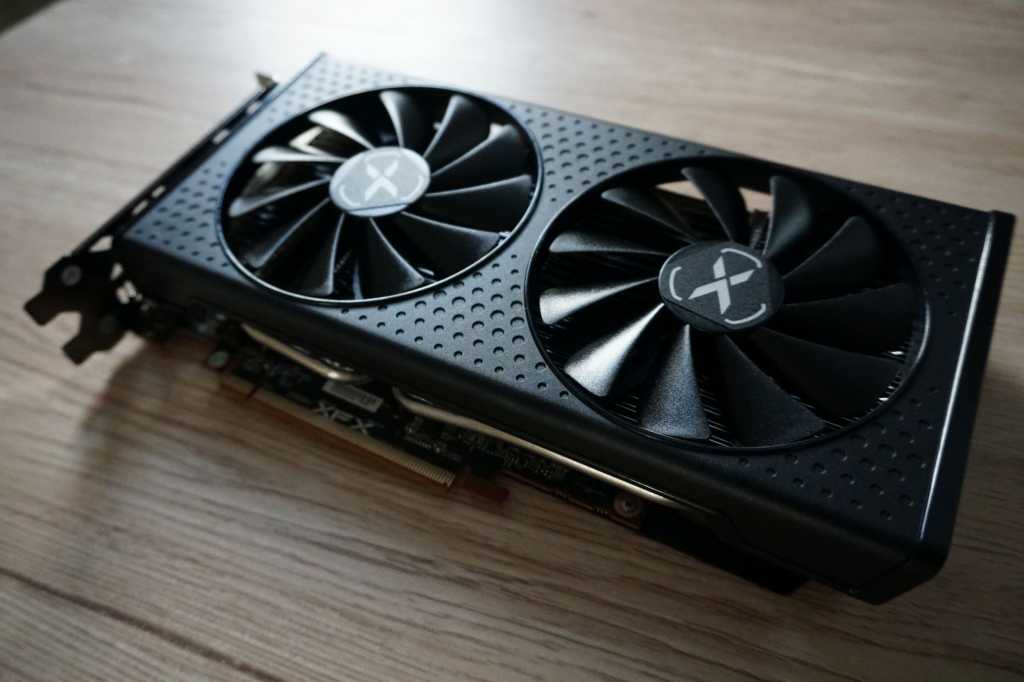At a glance
Expert’s Rating
Pros
- Great 1080p gaming with Ultra graphics
- 8GB of memory
- Incredibly power efficient
- AMD features like FSR, Radeon Boost, Smart Access Memory can make it faster
Cons
- Very high price for a 1080p graphics card (though more reasonable in today’s GPU shortage)
- Slower at ray tracing than Nvidia GPUs
- 1440p performance isn’t as impressive given unorthodox memory configuration
Our Verdict
AMD’s Radeon RX 6600 is the first true 1080p graphics card of this generation, finally. It’s fast and incredibly power efficient, but has a high price (that will soar even higher on the street) and isn’t a great 1440p option.
Price When Reviewed
$329
It’s finally happened. Well over a year after this generation of graphics cards kicked off, AMD is releasing the first true 1080p GPU of the lot with the Radeon RX 6600, which is being both announced and launched today.
Sure, the step-up Radeon RX 6600 XT ostensibly targets high-refresh rate 1080p gaming, but it’s massively overkill for gaming on a standard 60Hz monitor. And the rival GeForce RTX 3060 doesn’t offer enough GPU grunt for no-compromises 1440p, but Nvidia ladened it with a ludicrous 12GB of VRAM, which contributes to its sky-high street price.
The Radeon RX 6600 offers very good Ultra-quality 1080p gaming paired with 8GB of GDDR6 memory, a remarkably sane combination. Its $329 suggested price might raise an eyebrow at first blush; that matches the MSRP of the RTX 3060, and AMD’s card is both slower and packs 4GB less VRAM. But you’ll find the RTX 3060 going for $675 to $850 on Ebay, way above its official $330 MSRP. In fact, the Radeon RX 6600 XT sells for less than the RTX 3060 online despite being faster across the board—you can find it for $575 to $675 on Ebay.
Still, expect the Radeon RX 6600 to command a markup on the streets. But given all those pricing intricacies and the ongoing GPU shortage, AMD’s street price feels reasonable for the hardware on offer—even if being forced to pay well over $300 for great 1080p performance remains very unreasonable unless you have deep pockets or little patience.
Radeon RX 6600 specs, features, and design
The Radeon RX 6600 sports a cut-down version of the “Navi 23” GPU that debuted in the Radeon RX 6600 XT.
AMD
The new GPU features 28 compute units, compared to 32 in the Radeon RX 6600 XT (and 36 in last-generation’s Radeon RX 5600 XT). More significantly, AMD neutered this lower-end GPU by greatly reducing the amount of power provided—132 watts, versus 160W in the XT model—and cranking back Game Clock speeds by a whopping 300MHz plus. The Radeon RX 6600 is rated for 2044MHz Game Clock speeds, compared to 2359MHz in the 6600 XT. That, paired with key improvements in how AMD made its RDNA 2 architecture, makes the Radeon RX 6600 very power efficient.
Part of that power efficiency comes from its unique memory configuration. Well, not totally unique—the Radeon RX 6600 copies the memory loadout of its pricier XT brethren. Here’s what we said about the memory during that review, which also applies to this non-XT model:
Part of the reason AMD’s new cards are so power efficient is the addition of “Infinity Cache,” a large blob of L3 memory embedded right within the GPU die. Games tap into it for a lot of memory tasks, which means the GPU doesn’t need to send requests “all” the way out to the graphics card’s GDDR6 memory. That in turn lets AMD build Radeon RX 6000-series GPUs with smaller memory buses, which helps save power. The [Radeon RX 6600] features a narrow 128-bit memory bus (think of it as the highway for memory data—more lanes lets traffic move faster) versus a 192-bit bus on the older 5600 XT, and a 256-bit bus on the 5700 XT.
It’s not all roses though. AMD tuned the [Radeon RX 6600] Infinity Cache for 1080p gaming, giving it significantly less capacity than its brethren—32MB, versus 96MB on the 1440p-focused Radeon RX 6700 XT and 128GB on AMD’s higher-end 4K options. Radeon product manager Nish Neelalojanan told me that the “hit rate” that determines the Infinity Cache’s effectiveness is “very similar” in the 6600 XT at 1080p to what the other cards achieve at their targeted resolutions.

AMD
But as you’ll see in our benchmarks, if you try to step the resolution up to 1440p, the Infinity Cache’s hit rate decreases significantly, meaning the Radeon RX 6600 needs to instead rely on the traditional memory system much more. When that happens, the Radeon RX 6600’s relative performance plummets compared to graphics cards that feature more traditional larger memory buses and higher overall memory bandwidth (though the lower memory bandwidth also makes modern Radeon GPUs less attractive to crypto-miners). Bottom line? This graphics card truly was built for 1080p gaming, though you can still get a decent 1440p experience if you don’t mind dipping slightly below 60 frames per second, or dialing your graphics options down a bit.
Speaking of “this card,” there is no reference version of the Radeon RX 6600. All the cards you’ll find for sale come from third-party graphics card vendors like Asus, Sapphire, MSI, and the star of this review, XFX.
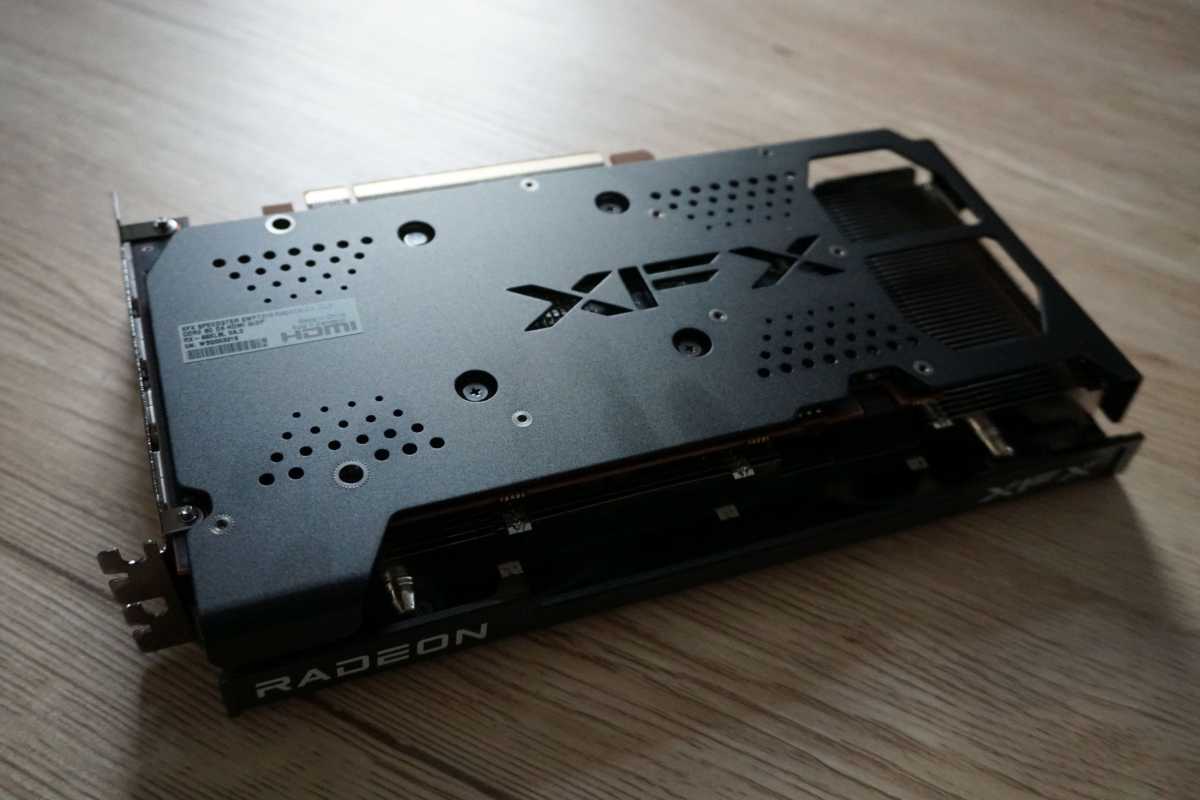
Brad Chacos/IDG
AMD sent us the XFX Radeon RX 6600 Swft 210 for review. It’s cool and quiet, with an attractive design reminiscent of XFX’s blacked-out style this generation, albeit in a smaller and more constrained package. It uses a pair of larger 100mm fans with 11 blades apiece (rather than the triple-fan configuration of costlier XFX options) sitting atop a heatsink with a pair of 6mm heatpipes snaking through it. While most higher-end GPUs wield monstrous triple-slot coolers, often paired with triple-pin power requirements, the XFX Swft 210 sticks to a standard 2-slot height. Between that and the single 8-pin power connector required, it should slip into almost any gaming PC as a no-hassle upgrade. It comes with a single HDMI 2.1 port and three DisplayPorts.
This more modestly priced card lacks some of the extra features found in more luxurious models. You won’t find integrated fan headers or even RGB lighting on offer here, though the XFX Swft 210 does include a dual-BIOS switch. That’s helpful in any troubleshooting endeavors and especially handy during overclocking attempts. It’s a welcome addition indeed, along with a metal backplate that will look nice and clean in your system.
The Swft 210 runs at the Radeon RX 6600’s reference speeds, and XFX says it should debut for “about” the suggested $329 price during the initial launch window for AMD’s new GPU.
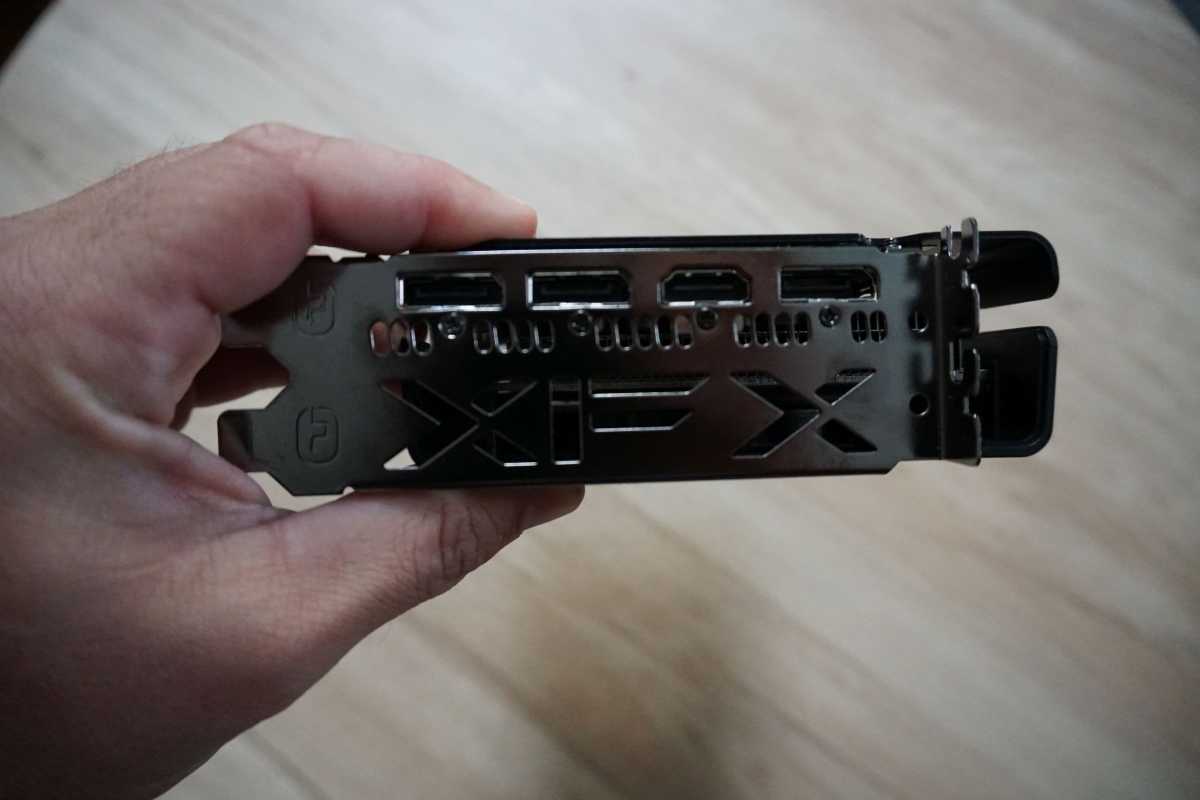
Port report
Brad Chacos/IDG
Like other RX 6000-series GPUs, the Radeon RX 6600 supports all of RDNA 2’s various features, including FidelityFX Super Resolution and Smart Access Memory to boost performance, real-time ray tracing capabilities, AV1 video decoding, DirectX 12 Ultimate goodies, an improved version of Radeon Boost that wraps in Variable Rate Shading, Radeon Anti-Lag across all major DX APIs, FreeSync display support, AMD Link streaming to other devices, and much more. AMD’s robust Radeon Settings app includes both manual and automatic performance tuning controls so you can tweak the card to your heart’s extent.
Let’s get benchmarking.
Our test system
We evaluate graphics cards on our dedicated AMD Ryzen 5000-series test rig in order to benchmark the effect of PCIe 4.0 support on modern GPUs, as well as the performance-boosting AMD Smart Access Memory and Nvidia Resizable BAR features (which are both based on the same underlying PCIe standard). Currently, we’re testing on an open bench with AMD’s Wraith Max air cooler; in the future, we’ll be moving the setup into a case and adding an NZXT Kraken liquid cooler to the mix. Most of the hardware was provided by the manufacturers, but we purchased the storage ourselves.
- AMD Ryzen 5900X, stock settings
- AMD Wraith Max cooler
- MSI Godlike X570 motherboard
- 32GB G.Skill Trident Z Neo DDR4 3800 memory
- EVGA 1200W SuperNova P2 power supply ($352 on Amazon)
- 1TB SK Hynix Gold S31 SSD
We’re comparing the $330 XFX Radeon RX 6600 Swft 210 against the $550 Asus ROG Strix Radeon RX 6600 XT, $330 EVGA GeForce RTX 3060 XC Black, and last generation’s $350 Radeon RX 5700 (non-XT) and $350 GeForce RTX 2060. That should provide a well-rounded view of the $300 price bracket in recent times, though it’s worth noting that all of these graphics cards sell for significantly higher on the streets these days. Yes, even the older ones.
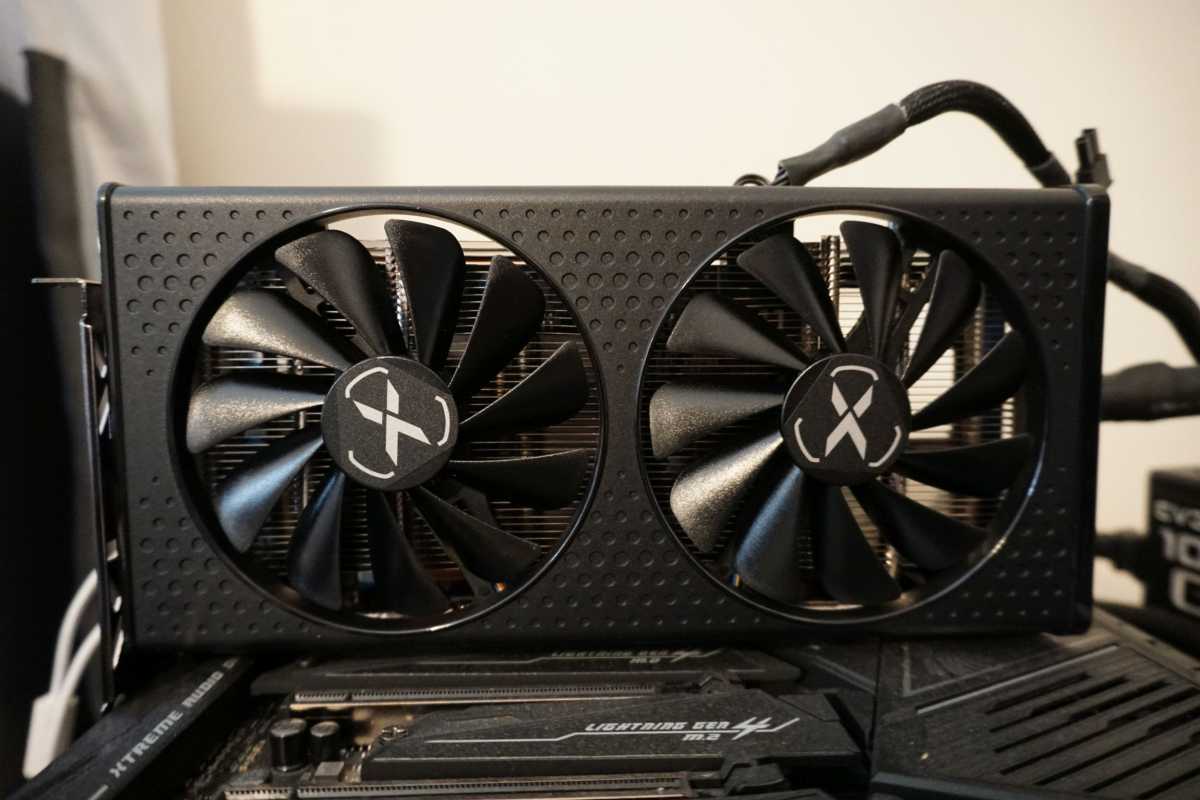
The XFX Radeon RX 6600 Swft 210 in our test system.
Brad Chacos/IDG
We test a variety of games spanning various engines, genres, vendor sponsorships (Nvidia, AMD, and Intel), and graphics APIs (DirectX 11, DX12, and Vulkan). Each game is tested using its in-game benchmark at the highest possible graphics presets unless otherwise noted, with VSync, frame rate caps, real-time ray tracing or DLSS effects, and FreeSync/G-Sync disabled, along with any other vendor-specific technologies like FidelityFX tools or Nvidia Reflex. We’ve also enabled temporal anti-aliasing (TAA) to push these cards to their limits. We run each benchmark at least three times and list the average result for each test.
AMD suggested testing this card against the RTX 3060 with Smart Access Memory and PCIe Resizable BAR on, respectively; we did not. Those newer capabilities can indeed increase performance, often in AMD’s favor, but they’re not enabled on most gaming PCs out there. If your rig supports Smart Access Memory, expect to see slightly faster performance in some modern games, though some rare games (like Assassin’s Creed Valhalla) run much faster with those features active.
We’re simply going to provide the charts during this game benchmarking portion, saving most commentary for our summary at the end of the review.
Gaming performance benchmarks
Watch Dogs: Legion
Watch Dogs: Legion is one of the first games to debut on next-gen consoles. Ubisoft upgraded its Disrupt engine to include cutting-edge features like real-time ray tracing and Nvidia’s DLSS. We disable those effects for this testing, but Legion remains a strenuous game even on high-end hardware with its optional high-resolution texture pack installed.
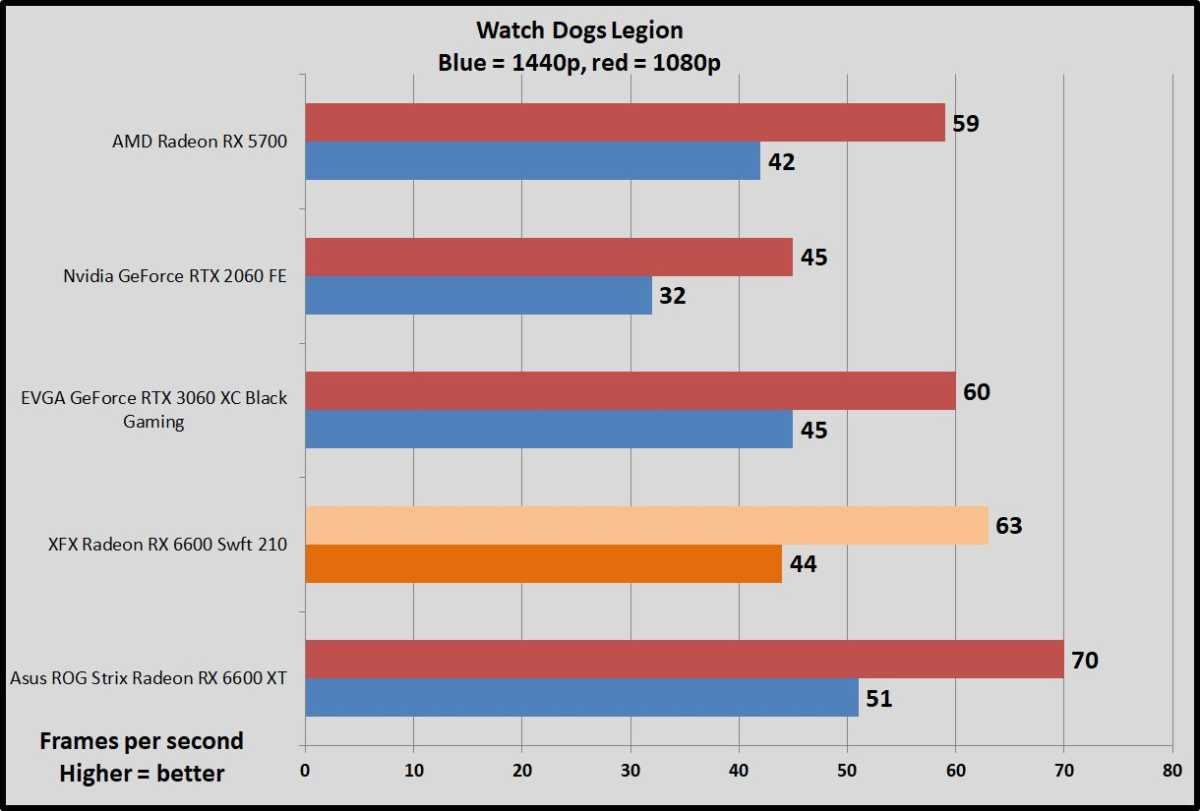
Brad Chacos/IDG
Horizon Zero Dawn
Yep, PlayStation exclusives are coming to the PC now. Horizon Zero Dawn runs on Guerrilla Games’ Decima engine, the same engine that powers Death Stranding.
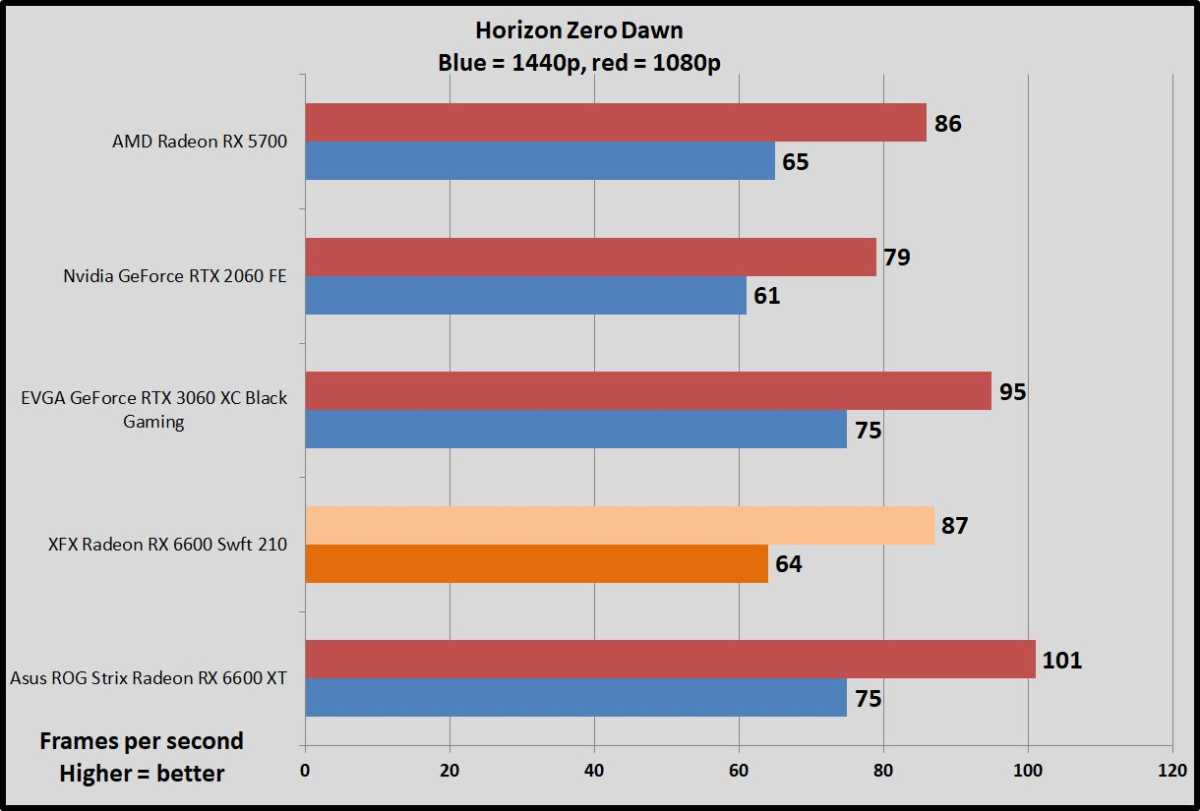
Brad Chacos/IDG
Gears Tactics
Gears Tactics puts it own brutal, fast-paced spin on the XCOM-like genre. This Unreal Engine 4-powered game was built from the ground up for DirectX 12, and we love being able to work a tactics-style game into our benchmarking suite. Better yet, the game comes with a plethora of graphics options for PC snobs. More games should devote such loving care to explaining what flipping all these visual knobs mean.
You can’t use the presets to benchmark Gears Tactics, as it intelligently scales to work best on your installed hardware, meaning that “Ultra” on one graphics card can load different settings than “Ultra” on a weaker card. We manually set all options to their highest possible settings.
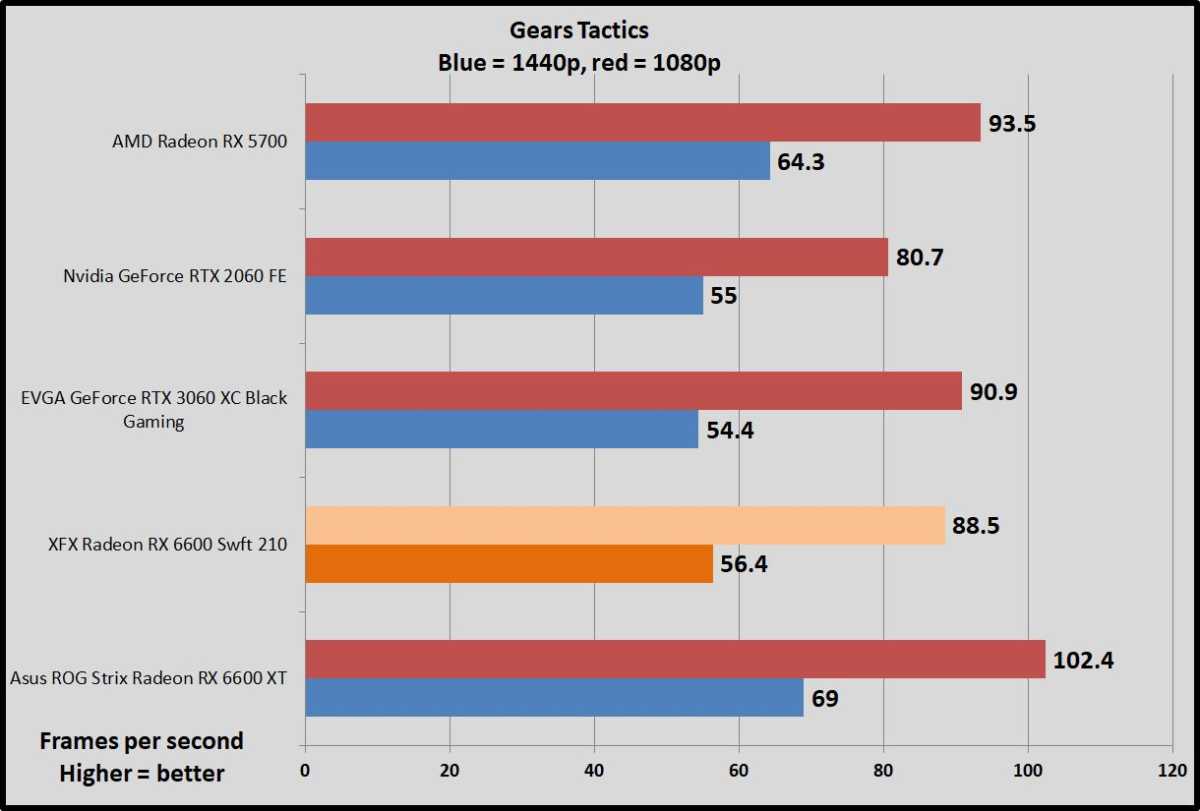
Brad Chacos/IDG
Wolfenstein: Youngblood
Wolfenstein: Youngblood is more fun when you can play cooperatively with a buddy, but it’s a fearless experiment—and an absolute technical showcase. Running on the Vulkan API, Youngblood achieves blistering frame rates, and it supports all sorts of cutting-edge technologies like ray tracing, DLSS 2.0, HDR, GPU culling, asynchronous computing, and Nvidia’s Content Adaptive Shading. The game includes a built-in benchmark with two different scenes; we tested Riverside.
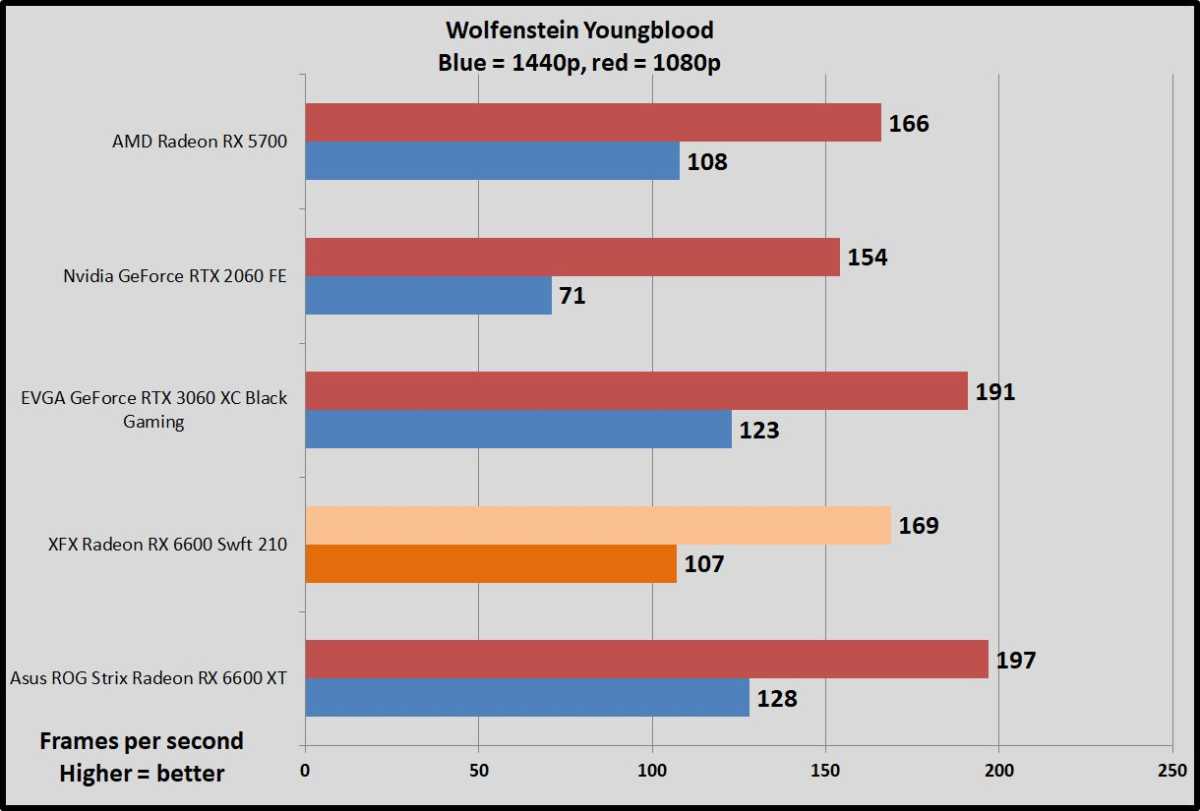
Brad Chacos/IDG
Metro Exodus
One of the best games of 2019, Metro Exodus remains one of the best-looking games around, too. The latest version of the 4A Engine provides incredibly luscious, ultra-detailed visuals, with one of the most stunning real-time ray tracing implementations released yet. The Extreme graphics preset we benchmark can melt even the most powerful modern hardware, as you’ll see below, though the game’s Ultra and High presets still look good at much higher frame rates.
We test in DirectX 12 mode with ray tracing, Hairworks, and DLSS disabled.
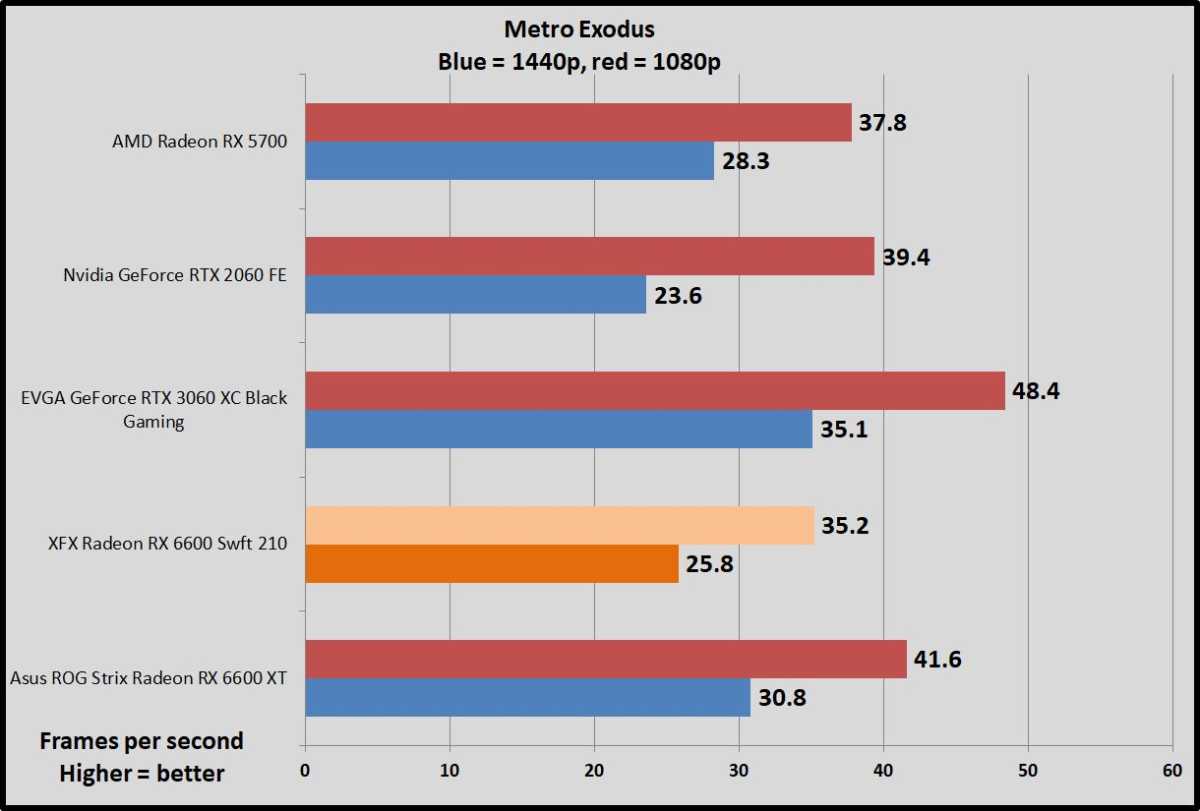
Brad Chacos/IDG
Borderlands 3
Borderlands is back! Gearbox’s game defaults to DX12, so we do as well. It gives us a glimpse at the ultra-popular Unreal Engine 4’s performance in a traditional shooter. This game tends to favor AMD hardware.
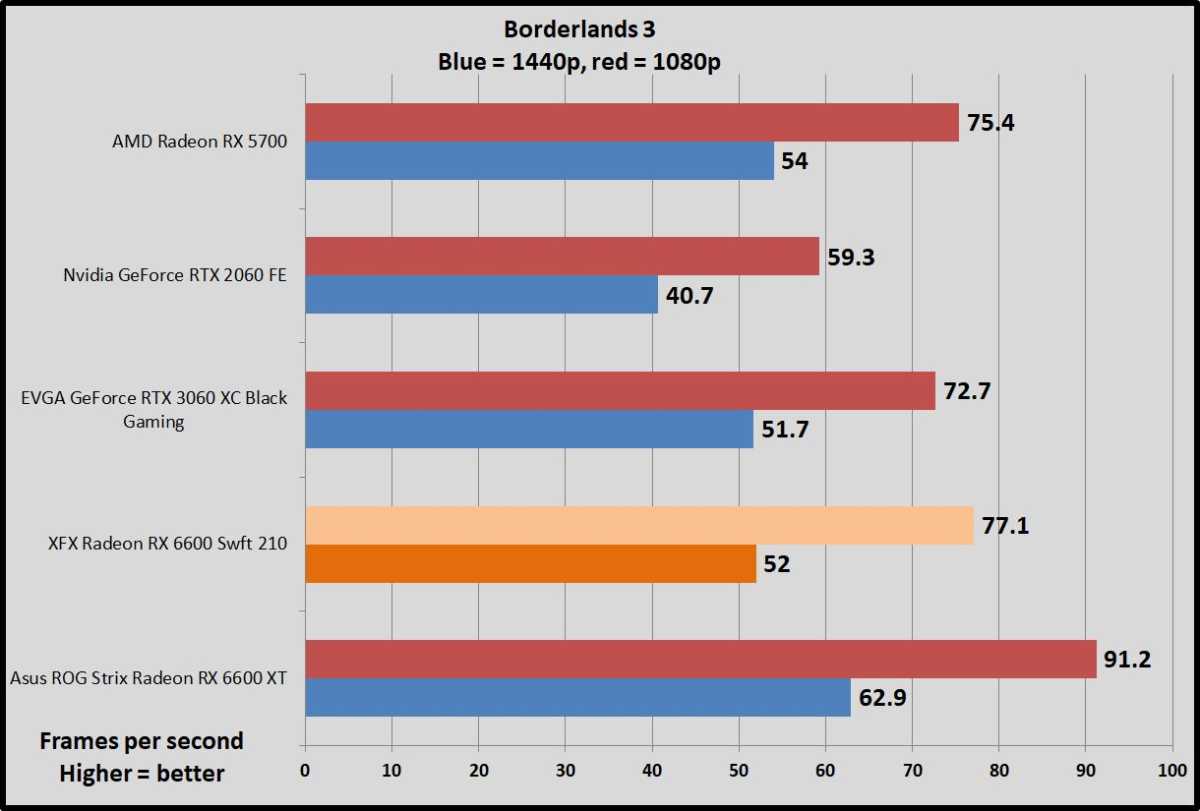
Brad Chacos/IDG
Strange Brigade
Strange Brigade is a cooperative third-person shooter where a team of adventurers blasts through hordes of mythological enemies. It’s a technological showcase, built around the next-gen Vulkan and DirectX 12 technologies and infused with features like HDR support and the ability to toggle asynchronous compute on and off. It uses Rebellion’s custom Azure engine. We test using the Vulkan renderer, which is faster than DX12.
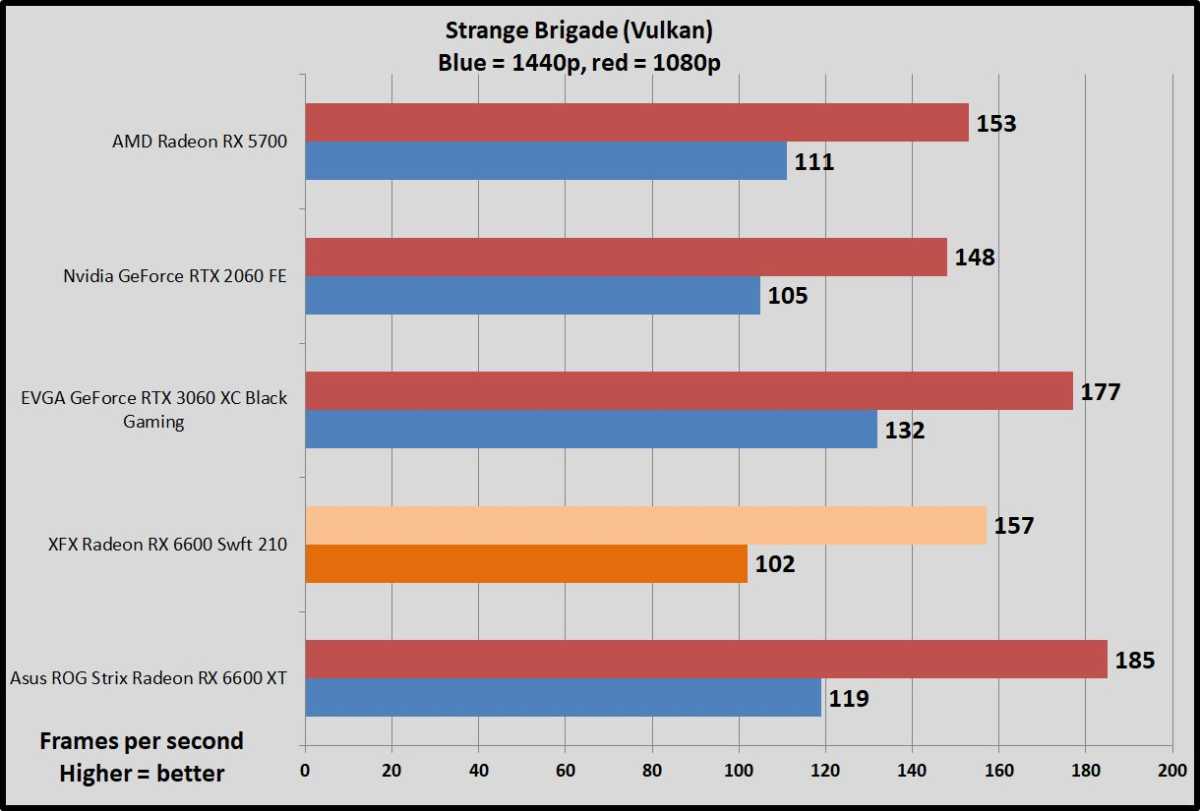
Brad Chacos/IDG
Total War: Troy
The latest game in the popular Total War saga, Troy was given away free for its first 24 hours on the Epic Games Store, moving over 7.5 million copies before it went on proper sale. Total War: Troy is built using a modified version of the Total War: Warhammer 2 engine, and this DX11 title looks stunning for a turn-based strategy game. We test the more intensive battle benchmark.
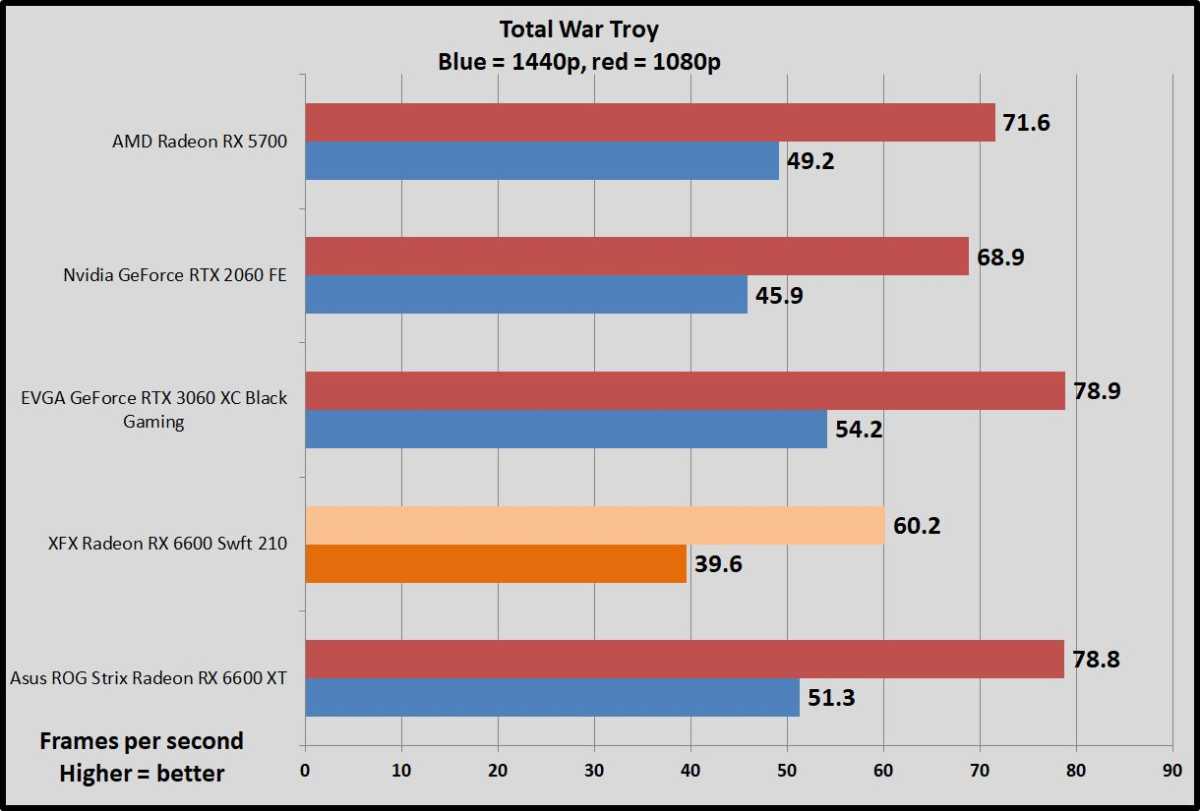
Brad Chacos/IDG
F1 2020
F1 2020 is a gem to test, supplying a wide array of both graphical and benchmarking options, making it a much more reliable (and fun) option that the Forza series. It’s built on the latest version of Codemasters’ buttery-smooth Ego game engine, complete with support for DX12 and Nvidia’s DLSS technology. We test two laps on the Australia course, with clear skies on and DLSS off.
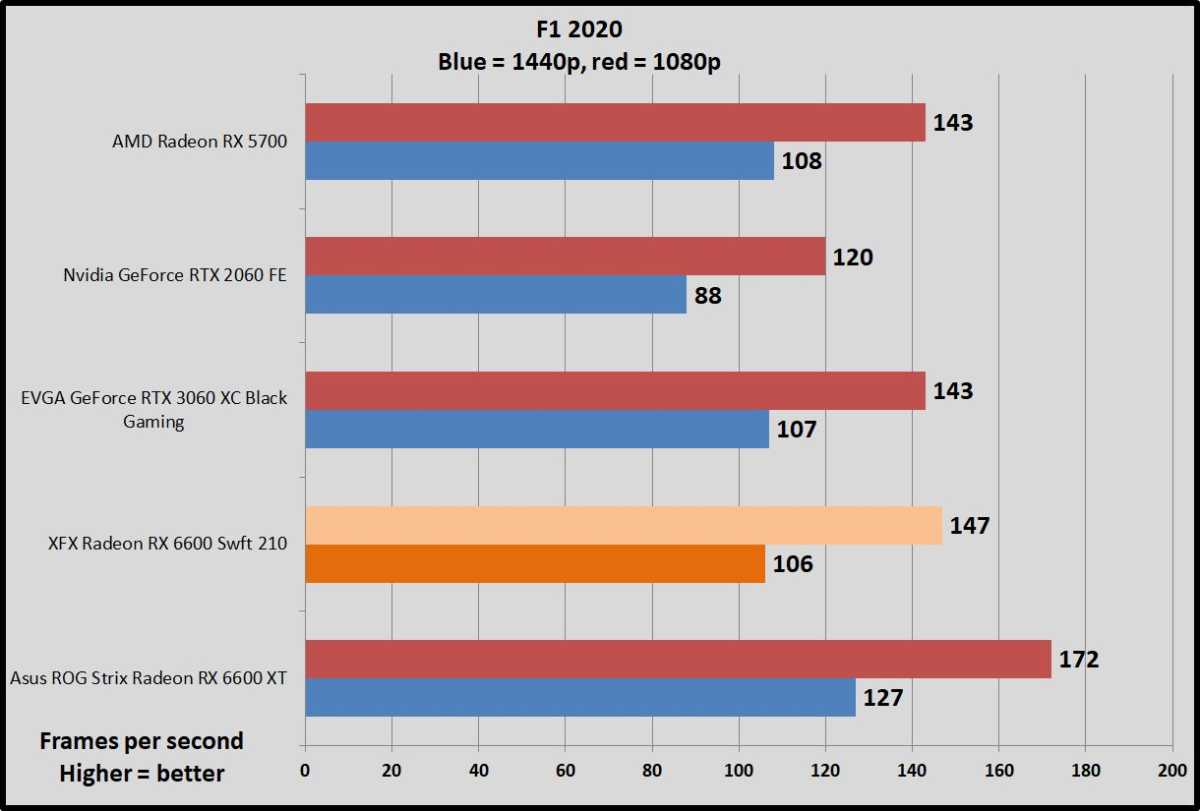
Brad Chacos/IDG
Shadow of the Tomb Raider
Shadow of the Tomb Raider concludes the reboot trilogy, and it’s still utterly gorgeous a couple of years after its debut. Square Enix optimized this game for DX12 and recommends DX11 only if you’re using older hardware or Windows 7, so we test with DX12. Shadow of the Tomb Raider uses an enhanced version of the Foundation engine that also powered Rise of the Tomb Raider and includes optional real-time ray tracing and DLSS features.
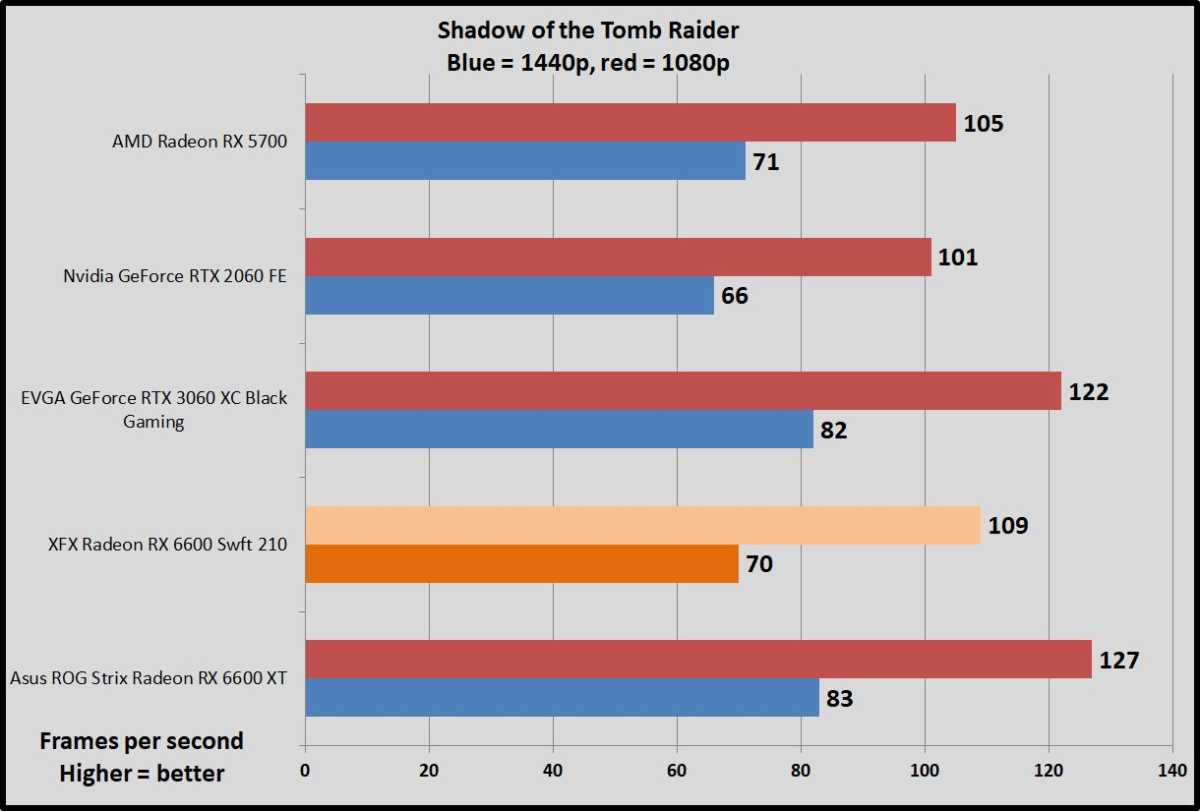
Brad Chacos/IDG
Rainbow Six Siege
Rainbow Six Siege still dominates the Steam charts years after its launch, and Ubisoft supports it with frequent updates and events. The developers have poured a ton of work into the game’s AnvilNext engine over the years, eventually rolling out a Vulkan version of the game that we use to test. By default, the game lowers the render scaling to increase frame rates, but we set it to 100 percent to benchmark native rendering performance on graphics cards. Even still, frame rates soar.
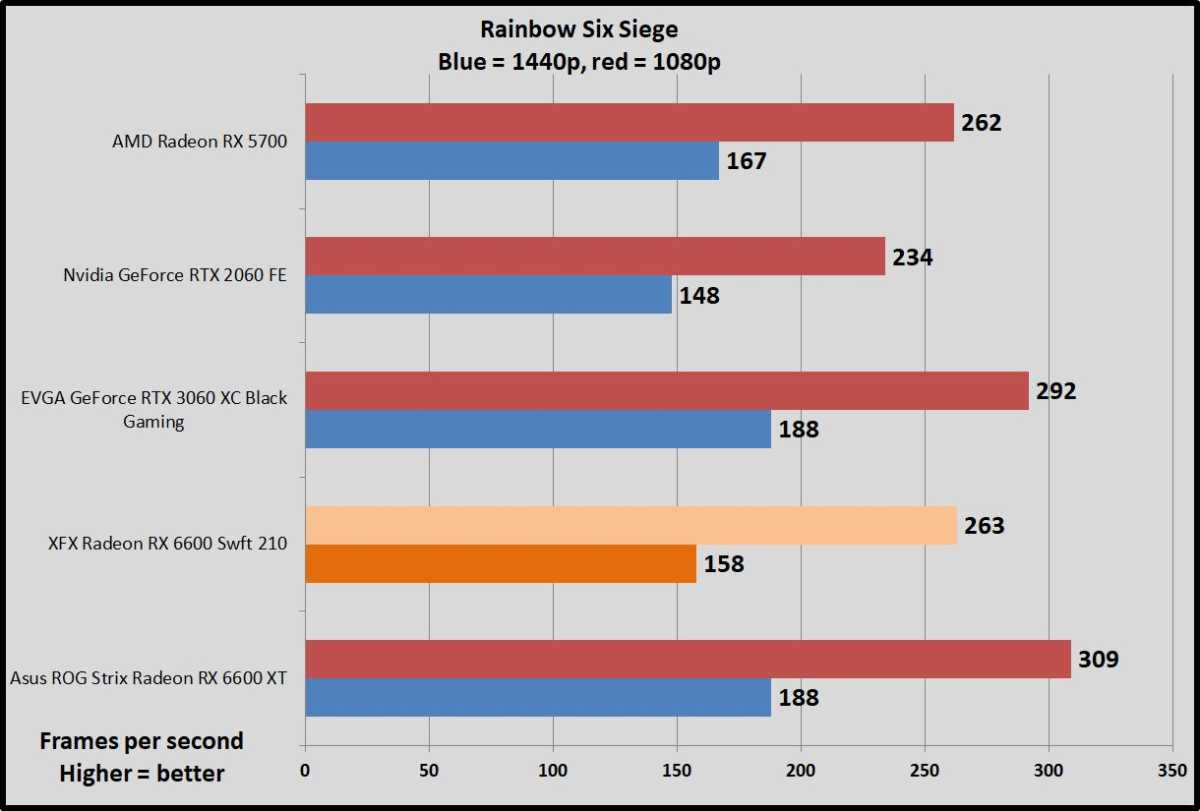
Brad Chacos/IDG
Ray tracing performance
We briefly tested ray tracing performance using Shadow of the Tomb Raider and Metro Exodus, two games in our suite that support the cutting-edge technology. The tests were conducted at 1080p resolution without Nvidia’s AI-enhance DLSS technology enabled, which both early ray tracing titles support. Image upsampling technologies like DLSS and AMD’s FidelityFX Super Resolution are key to clawing back frames lost to cutting-edge ray tracing effects, increasing performance by rendering visuals internally at a lower resolution before using various tricks to increase the final resolution. The software techniques work in very different ways, however, so testing with them disabled is the only way for an apples-to-apples benchmark except in the ultra-rare games that support both DLSS and FSR, like Marvel’s Avengers.
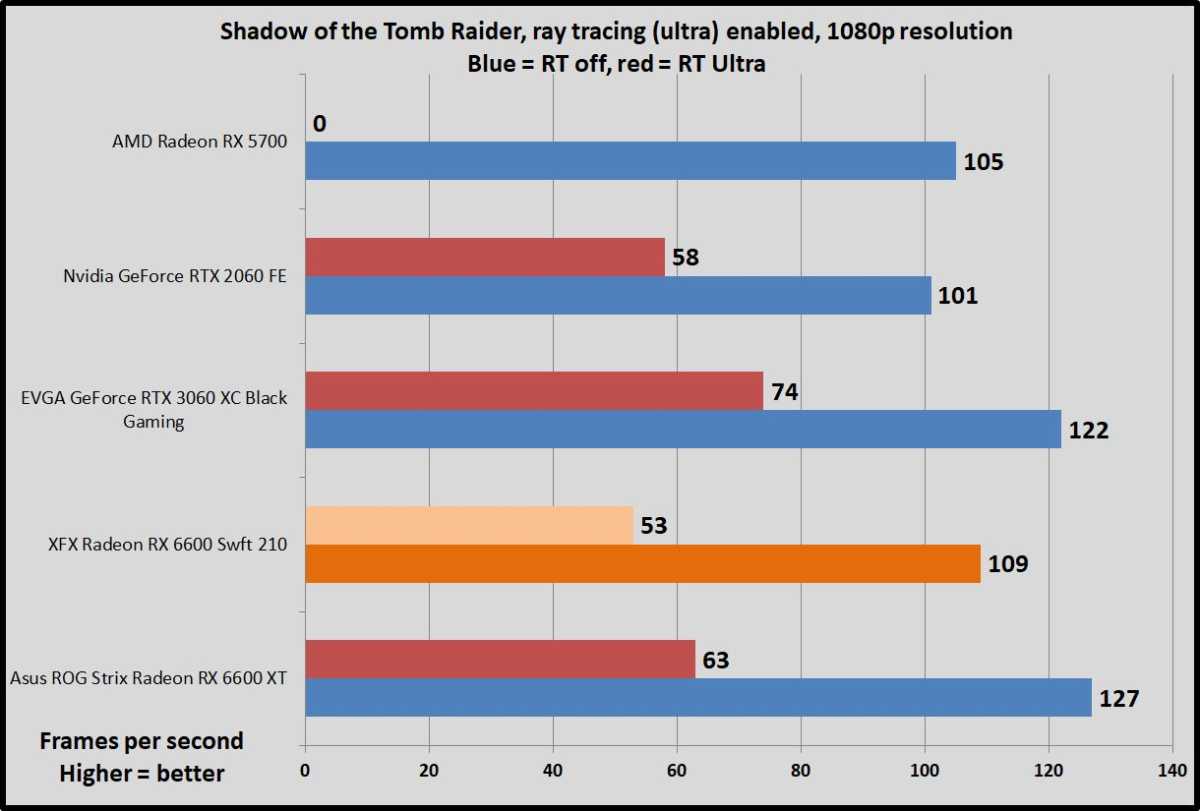
Brad Chacos/IDG

Brad Chacos/IDG
This largely confirms what we already knew from higher-end Radeon and GeForce GPUs. (AMD’s last-gen Radeon RX 5700 does not support ray tracing, hence the zero score in RT benchmarks above.) Nvidia’s second-generation implementation of ray tracing hardware performs better than AMD’s first stab at the technology, though both enable you to play ray traced games after making some graphics option tweaks (or enabling DLSS/FSR).
Power draw, thermals, and noise
We test power draw by looping the F1 2020 benchmark at 4K for about 20 minutes after we’ve benchmarked everything else and noting the highest reading on our Watts Up Pro meter, which measures the power consumption of our entire test system. The initial part of the race, where all competing cars are onscreen simultaneously, tends to be the most demanding portion.
This isn’t a worst-case test; this is a GPU-bound game running at a GPU-bound resolution to gauge performance when the graphics card is sweating hard. If you’re playing a game that also hammers the CPU, you could see higher overall system power draws. Consider yourself warned.
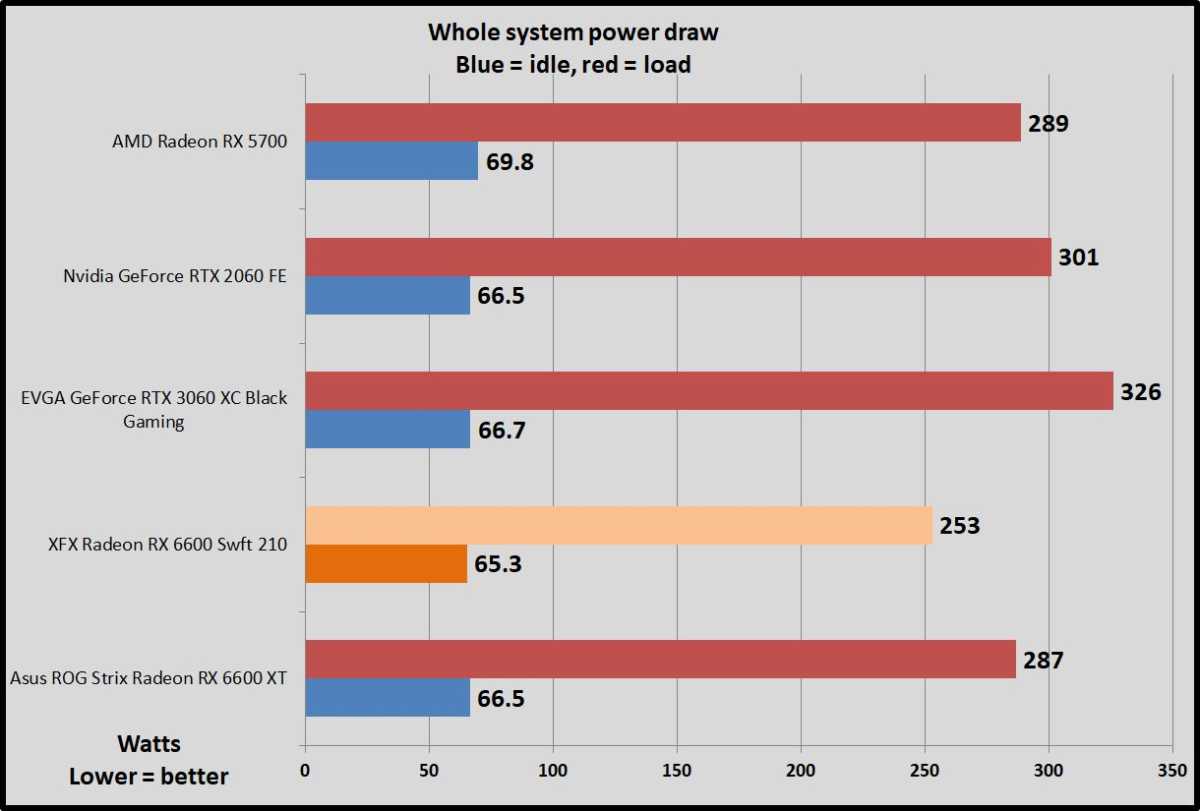
Brad Chacos/IDG
The Radeon RX 6600 is by far the most power efficient GPU of this bunch, drawing a staggering 73 fewer watts than the RTX 3060. RDNA 2’s efficiency has been a big win for AMD this generation, and pairing that with the lower power requirements and clock speeds in the Radeon RX 6600 (to create more differentiation versus the XT model, no doubt) means this GPU barely sips any juice.
We test thermals by leaving GPU-Z open during the F1 2020 power draw test, noting the highest maximum temperature at the end.
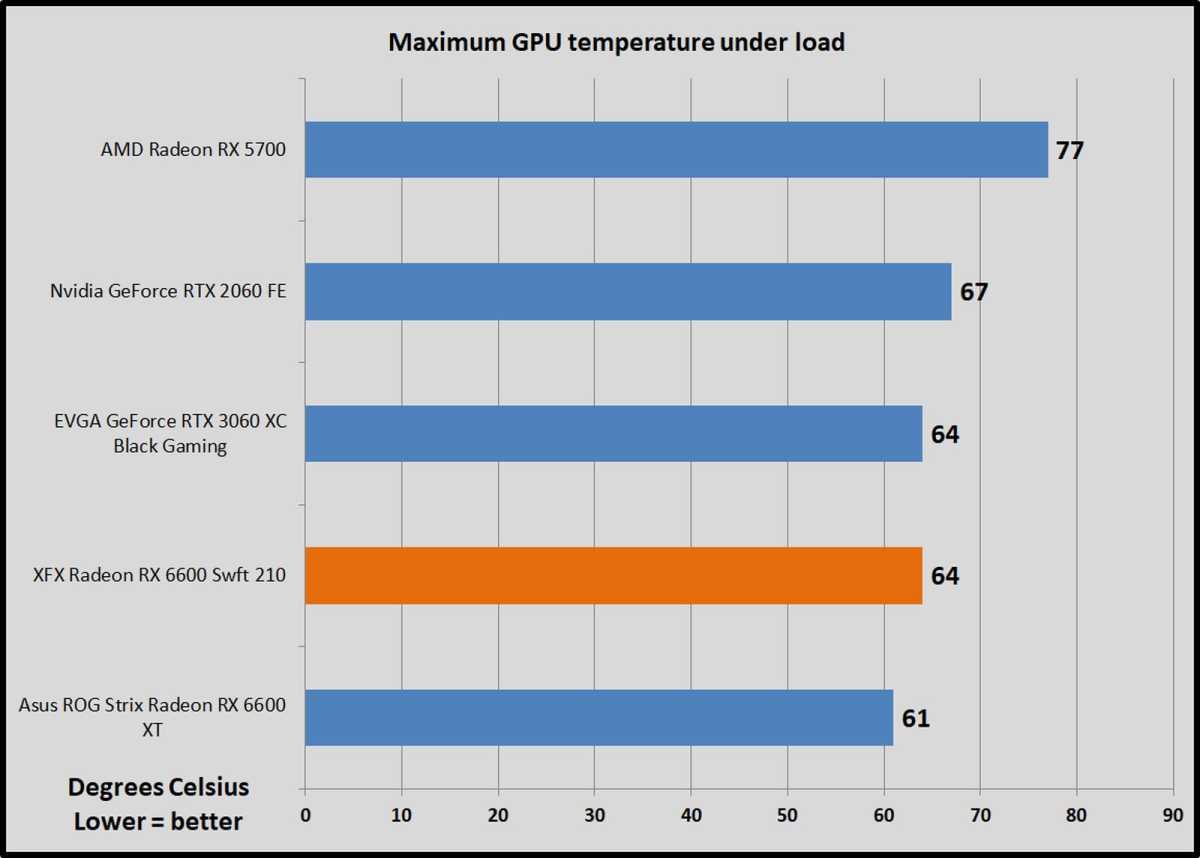
Brad Chacos/IDG
Even with its smaller design, the XFX Swft 210 delivers outstanding cooling. Of course, a lot of that has to do with the RX 6600’s more humble clock speeds and power draw, as well. You don’t need a massive custom cooler to keep a small, power-sipping chip chilly.
Should you buy the Radeon RX 6600?
You probably shouldn’t buy any graphics card right now, as I’ve said to close every graphics card review in 2021. Prices remain outrageous even all these months later. I’d recommend most people sit on the sidelines and stream their PC games via Nvidia’s GeForce Now service—or maybe even consider buying a console—until the dust settles.
The Radeon RX 6600 is the first true 1080p graphics card of this generation, and it shines in that role—you can crank up a game’s eye candy to the max and the power-sipping nature of this GPU means your rig will still run cool and quiet. (Though you can still get a decent 1440p experience if you don’t mind possibly dipping below 60 frames per second, or dialing your graphics options down a bit.) You won’t be spending extra on excessive VRAM for this resolution, unlike on the RTX 3060. And with miners preferring the memory configuration of GeForce GPUs, paired with the small die size of the Radeon RX 6600, we’re hopeful that we’ll see a (somewhat) more decent supply of this AMD GPU on store shelves in the early days. The recent 6600 XT launch offered stock levels that made the idea of buying one laughable, for example, but not impossible.
In a sane world we’d spend more time raging at the idea of spending $330-plus on a solid 1080p graphics card in 2021, half a decade after AMD’s own Radeon RX 480 offered no-compromises 1080p and solid 1440p gaming for $200. The Radeon RX 6600 also sometimes (though rarely) loses to Nvidia’s older RTX 2060 over two-and-a-half years after that card’s debut. In a vacuum, this card’s price-to-performance should be disappointing. And deep down, it really is. I’d rather spend $300 on an Xbox Series S to be frank. (You know, if you could find one.)
But in this wild year full of pandemics and crippling supply shortages, $330 seems like a reasonable ask for the Radeon RX 6600. You’ll currently pay more than that for an ancient Radeon RX 580 on the streets. If supplies of the Radeon RX 6600 impress in the early days, and prices stay somewhat close to the card’s MSRP, this may be your best shot at an upgrade in a long time, even if the cost does make it hard to get excited about. It is what it is right now. Pay up if you must, but sit on the sidelines for now if you can.
If you do decide to bite the bullet, fear not: The Radeon RX 6600 is an excellent GPU for 1080p gaming, although it struggles against Nvidia’s more mature implementation in ray-traced games. And the XFX Swft 210 specifically stays cool while looking good; it’s strongly worth considering if you don’t need a version of the RX 6600 with more elaborate features or RGB lighting.

